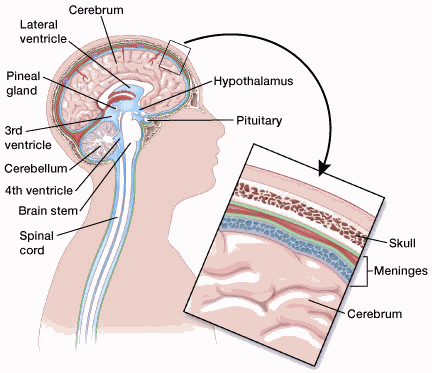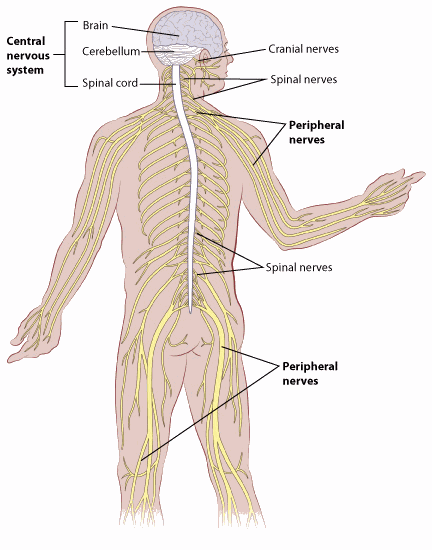Your gift is 100% tax deductible
What Are Adult Brain and Spinal Cord Tumors?
Brain and spinal cord tumors are masses of abnormal cells in the brain or spinal cord that have grown out of control.
In most other parts of the body, it is very important to distinguish between benign (non-cancerous) tumors and malignant tumors (cancers). Benign tumors do not grow into nearby tissues or spread to distant areas, so benign tumors in other parts of the body are almost never life-threatening. One of the main reasons malignant tumors are so dangerous is because they can spread throughout the body.
Brain tumors rarely spread to other parts of the body, but most of them can spread through the brain tissue. Even so-called benign brain tumors can, as they grow, press on and destroy normal brain tissue, which can lead to serious or sometimes even life-threatening damage. For this reason, doctors usually speak of brain tumors rather than brain cancers. The main concerns with brain and spinal cord tumors are:
- How fast they grow
- How readily they spread through the rest of the brain or spinal cord
- Where they are located
- If they can be removed (or destroyed) and not come back
But both benign and malignant brain and spinal cord tumors can be life threatening.
Brain and spinal cord tumors tend to be different in adults and children. They often form in different areas, develop from different cell types, and may have a different outlooks and treatments.
Information on these types of tumors in children is covered in Brain and Spinal Cord Tumors in Children.
The central nervous system
To understand brain and spinal cord tumors, it helps to know about the normal structure and function of the central nervous system (CNS), which is the medical name for the brain and spinal cord.
The brain is the center of thought, feeling, memory, speech, vision, hearing, movement, breathing, and much more. The spinal cord and special nerves in the head called cranial nerves help carry messages between the brain and the rest of the body. These messages tell our muscles how to move, transmit information gathered by our senses, and help coordinate the functions of our internal organs.
The brain is protected by the skull. Likewise, the spinal cord is protected by the bones (vertebrae) of the spinal column.
The brain and spinal cord are surrounded and cushioned by a special liquid, called cerebrospinal fluid (CSF). Cerebrospinal fluid is made by the choroid plexus, which is found in spaces within the brain called ventricles. The ventricles and the spaces around the brain and spinal cord are filled with CSF.
Parts of the brain and spinal cord

The main areas of the brain include the cerebrum, cerebellum, and brain stem. Each part has a special function.
Cerebrum: The cerebrum is the large, outer part of the brain. It is divided into left and right hemispheres (halves) and controls reasoning, thought, emotion, and language. It is also responsible for planned (voluntary) muscle movements (throwing a ball, walking, chewing, etc.) and for taking in and interpreting sensory information such as vision, hearing, smell, touch, and pain.
Cerebellum: The cerebellum lies under the cerebrum at the back part of the brain. It helps coordinate movement.
Brain stem: The brain stem is the lower part of the brain that connects to the spinal cord. It contains bundles of very long nerve fibers that carry signals controlling muscles and sensation or feeling between the cerebrum and the rest the body. Special centers in the brain stem also help control breathing and the beating of the heart. Also, most cranial nerves (described below) start in the brain stem.
The brain stem is divided into 3 main parts: the midbrain, pons, and medulla oblongata.
Because the brain stem is a small area that is so essential for life, it might not be possible to surgically remove tumors in this area.
Cranial nerves: The cranial nerves extend directly out of the base of the brain (as opposed to coming out of the spinal cord). These nerves carry signals directly between the brain and the face, eyes, ears, tongue, mouth, and some other areas.
Spinal cord: The spinal cord is made up of bundles of very long nerve fibers that carry signals related to muscle control, sensation or feeling, and bladder and bowel control.

Pituitary gland and hypothalamus: The pituitary is a small gland at the base of the brain. It is connected to a part of the brain called the hypothalamus. They work together to make hormones that help regulate the activity of several other glands in the body. For example:
- They control the amount of thyroid hormone made by the thyroid gland.
- They affect breast milk production and release.
- They control the amount of male or female hormones made by the testicles or ovaries.
- They make growth hormone, which stimulates body growth.
- They make vasopressin, which regulates water balance by the kidneys.
The growth of tumors in or near the pituitary or hypothalamus, as well as surgery and/or radiation therapy in this area, can affect these functions. For example, tumors starting in the pituitary gland sometimes make too much of a certain hormone, which can cause problems. On the other hand, a person may have low levels of one or more hormones after treatment and may need to take hormones to make up for this.
Pineal gland: The pineal gland is not really part of the brain. It is a small endocrine gland that sits between the cerebral hemispheres. It makes melatonin, a hormone that regulates sleep, in response to changes in light. The most common tumors of the pineal gland are called pineoblastomas.
Blood-brain barrier: The inner lining of the small blood vessels (capillaries) in the brain and spinal cord creates a very selective barrier between the blood and the tissues of the central nervous system. This barrier normally helps maintain the brain’s metabolic balance and keeps harmful toxins from getting into the brain. Unfortunately, it also keeps out most chemotherapy drugs that are used to kill cancer cells, which in some cases limits their usefulness.
Choroid plexus: The choroid plexus is the area of the brain within the ventricles that makes CSF, which nourishes and protects the brain.
Types of cells and body tissues in the brain and spinal cord
The brain and spinal cord have many kinds of tissues and cells, which can develop into different types of tumors.
Neurons (nerve cells): These are the cells in the brain that help determine thought, memory, emotion, speech, muscle movement, sensation, and just about everything else that the brain and spinal cord do.
Unlike many other types of cells that can grow and divide to repair damage from injury or disease, neurons in the brain and spinal cord largely stop dividing about a year after birth (with a few exceptions). Neurons do not usually form tumors, but they are often damaged by tumors that start nearby.
Glial cells: Glial cells are the supporting cells of the brain. Most brain and spinal cord tumors develop from glial cells. These tumors are sometimes referred to as gliomas.
There are 3 main types of glial cells:
- Astrocytes help support and nourish neurons. When the brain is injured, astrocytes form scar tissue that helps repair the damage. The main tumors starting in these cells are called astrocytomas or glioblastomas.
- Oligodendrocytes make myelin, a fatty substance that surrounds and insulates the nerve cell axons of the brain and spinal cord. This helps neurons send electric signals through the axons. Tumors starting in these cells are called oligodendrogliomas.
- Ependymal cells line the ventricles (fluid-filled areas) within the brain and form part of the pathway through which CSF flows. Tumors starting in these cells are called ependymomas.
(A fourth type of cell, called microglia, are the infection-fighting cells of the central nervous system. They are part of the immune system and are not truly glial cells.)
Neuroectodermal cells: These are very early forms of nervous system cells that are probably involved in brain cell development. They are found throughout the brain, although they are not often seen in the adult central nervous system. The most common tumors that come from these cells develop in the cerebellum and are called medulloblastomas.
Meninges: These are layers of tissue that line and protect the brain and spinal cord. CSF travels through spaces formed by the meninges. The most common tumors that start in these tissues are called meningiomas.
- Written by
- References

The American Cancer Society medical and editorial content team
Our team is made up of doctors and oncology certified nurses with deep knowledge of cancer care as well as editors and translators with extensive experience in medical writing.
Dorsey JF, Salinas RD, Dang M, et al. Chapter 63: Cancer of the central nervous system. In: Niederhuber JE, Armitage JO, Doroshow JH, Kastan MB, Tepper JE, eds. Abeloff’s Clinical Oncology. 6th ed. Philadelphia, Pa: Elsevier; 2020.
National Cancer Institute Physician Data Query (PDQ). Adult Central Nervous System Tumors Treatment. 2020. Accessed at www.cancer.gov/types/brain/hp/adult-brain-treatment-pdq on February 4, 2020.
Last Revised: May 5, 2020
American Cancer Society medical information is copyrighted material. For reprint requests, please see our Content Usage Policy.
American Cancer Society Emails
Sign up to stay up-to-date with news, valuable information, and ways to get involved with the American Cancer Society.



